FREE RESOURCE: Downloadable Preflop Charts

Level Up Your Game with FREE Preflop Charts!
Preflop Poker Charts – Always Know What Hands To Play!
Studying poker can seem like a daunting task, and getting a good starting point is often one of the things that many players struggle with.
If you are also wondering how to learn poker, we recommend you focus on the preflop play before everything else, and an extensive study of preflop charts will help you do just that.
Preflop charts are a visual representation of hands you should be playing in various situations and at various stack depths in different game formats.
On this page, you will gain access to downloadable preflop charts for tournament and cash games that will help you learn both the GTO and exploitative approach to these game formats and teach you how to make the best preflop play in every spot.
We will share preflop ranges with poker hands you should be opening in various situations, and if you want to get a full breakdown of how to play when facing an open, against 3-bets, or how to adjust with different stack sizes, download our charts available on this page.
Whether you are a tournament or cash game player, this page will give you access to preflop charts that you can use to take your game to the next level.
Poker Hand Charts for Tournaments
Tournament poker hand charts are designed to teach you what ranges to use before the flop in various tournament poker situations.
If you are new to tournament poker or are struggling with making the right preflop play in your MTTs, these charts will help you get the answers you need.
GTO Poker Charts as Your Starting Point
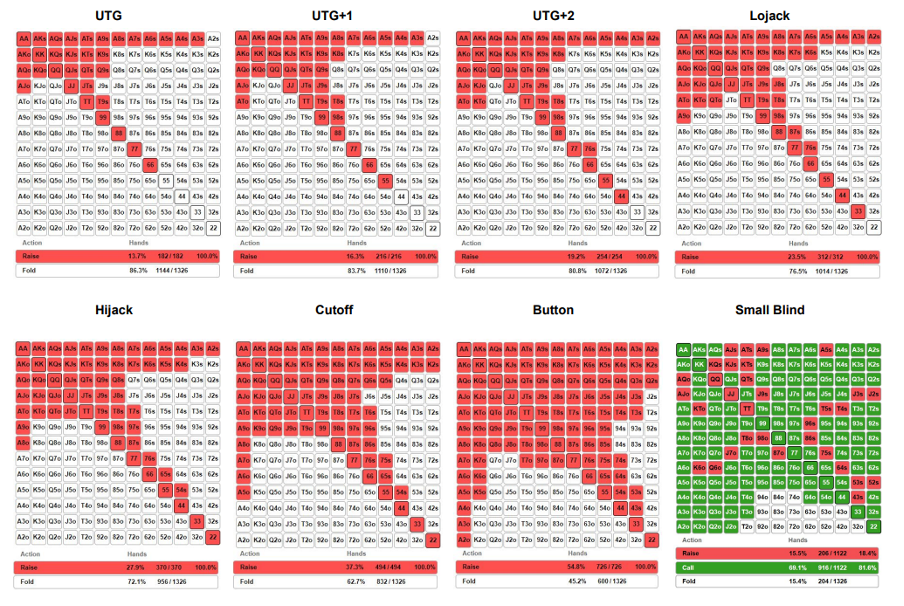
These are the hands you should be opening when playing with a 75bb stack in MTTs. To make it more convenient for you, we broke down these ranges by position at the table:
- UTG: 13.7% - 66+,A3s+,K9s+,Q9s+,AJo+,KQo
- UTG+1: 16.3% - 66+,A3s+,K8s+,Q9s+,J9s+,T9s,98s,ATo+
- UTG+2: 19.2% - 44+,A2s+,K8s+,Q9s+,J9s+,T8s+,98s,76s,ATo+,KTo+
- LJ: 23.5% - 33+,A2s+,K6s+,Q9s+,J8s+,T8s+,98s,87s,76s,A9o+,KTo+,QTo+
- HJ: 27.9% - 22+,A2s+,K4s+,Q8s+,J8s+,T7s+,97s+,87s,76s,65s,54s,A8o+,KTo+,QTo+,JTo
- CO: 37.3% - 22+,A2s+,K2s+,Q5s+,J7s+,T6s+,96s+,86s+,75s+,65s,54s,A5o+,K9o+,Q9o+,J9o+,T9o
- BTN: 54.8% - 22+,A2s+,K2s+,Q2s+,J3s+,T3s+,95s+,85s+,74s+,64s+,53s+,43s,A2o+,K5o+,Q8o+,J8o+,T7o+,97o+,87o
- SB: - Raise or Limp 81.6% - 22+,A2s+,K2s+,Q2s+,J2s+,T2s+,92s+,82s+,72s+,62s+,52s+,42s+,32s,A2o+,K2o+,Q2o+,J2o+,T3o+,95o+,85o+,75o+,64o+,54o
Game theory optimal (GTO) is a poker strategy that focuses on making perfectly balanced plays that work regardless of the strategies used by your opponents. The GTO preflop charts will be a great starting point that you can use when playing, but you will need to adjust these ranges when stacks shrink and you are left with 40, 25, or even 15 big blinds.
By studying the charts for different stack sizes, you will learn how poker solvers respond to the changing stack depth and which hands you should use as value and bluffing candidates in various scenarios.
Remember, GTO Poker Charts work against anyone, and if you are able to learn them well enough, your preflop game will be unexploitable and nearly perfect.
Exploitative Poker Hand Charts
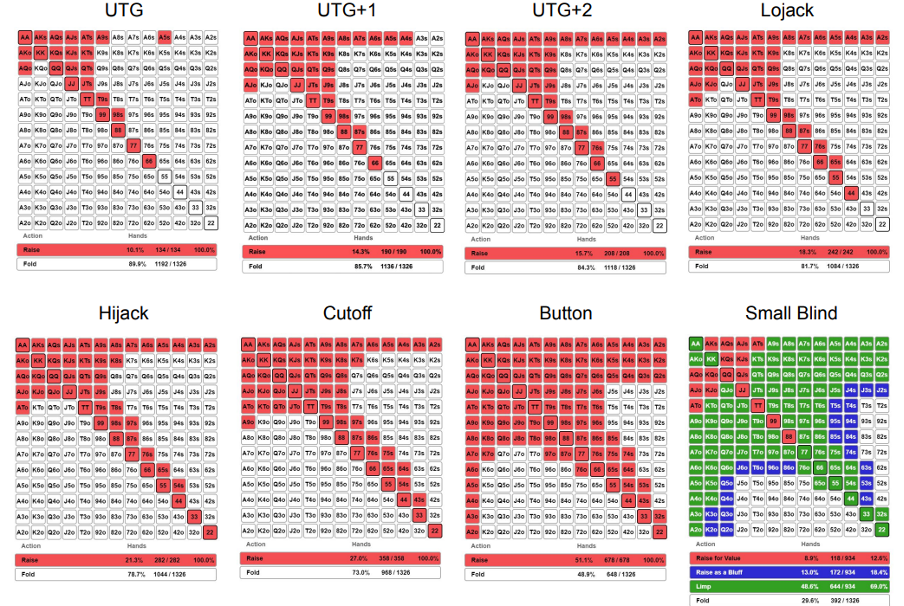
Contrary to GTO poker ranges, the exploitative approach helps you adjust to specific opponents and increase your EV against those players.
The Exploitative Poker Hand Charts are designed to teach you how to play tournament poker at deeper stack sizes (100bb) in an exploitative way that maximizes your edge against the population tendencies.
- UTG: 10.1% - 66+,A9s+,A5s,KTs+,QTs+,JTs,T9s,98s,AQo+
- UTG+1: 14.3% - 66+,A4s+,K9s+,Q9s+,J9s+,T9s,98s,AJo+,KQo
- UTG+2: 15.7% - 66+,A2s+,K9s+,Q9s+,J9s+,T9s,98s,87s,76s,AJo+,KQo
- LJ: 18.3% - 44+,A2s+,K9s+,Q9s+,J9s+,T9s,98s,87s,76s,65s,ATo+,KJo+
- HJ: 21.3% - 22+,A2s+,K8s+,Q9s+,J9s+,T9s,98s,87s,76s,65s,54s,ATo+,KJo+
- CO: 27% - 22+,A2s+,K7s+,Q8s+,J8s+,T8s+,97s+,86s+,75s+,64s+,54s,43s,A9o+,KJo+
- BTN: 51.3% - 22+,A2s+,K2s+,Q2s+,J6s+,T6s+,96s+,85s+,75s+,64s+,53s+,43s,32s,A2o+,K7o+,Q8o+,J8o+,T8o+,97o+,87o,76o
- SB: Raise or Limp 69% - 22+,A2s+,K2s+,Q2s+,J2s+,T4s+,94s+,84s+,74s+,63s+,53s+,43s,32s,A2o+,K2o+,Q2o+,J6o+,T6o+,96o+,86o+,76o
Unlike the GTO Poker Hand Charts, which are designed to protect us from being exploited, the Exploitative Poker Hand Charts are designed to take advantage of common player mistakes and optimize our win rate.
Learning which poker hands to play will take your game to the next level and allow you to dominate most tournament poker fields from every position.
The Exploitative Poker Hand Charts recommend the following raise sizes:
- 2.5x bb when raising first
- 3x the raise when 3-betting IP
- 2.5x the 3-bet when 4-betting IP
- 3.5 the raise when 3-betting OOP
- 2.75x the 3-bet when 4-betting OOP
Adjusting Based on Stack Depth
Adjusting your preflop ranges based on stack depth is one of the most important things you have to do as a tournament poker player.
Because the blinds are always going up in tournaments, your stack depth will change quite a bit throughout an event, with stacks oscillating from below 10 big blinds to as many as 300 big blinds.
If you want to be a winner in poker tournaments, you have to know how to play each stack depth, and it all starts with knowing what hands to play before the flop.
For example, if you compare the 75BB and the 15BB poker hand charts, you will notice there are significant differences in the way you should be playing your hands.
Looking at RFI ranges, you will notice the charts suggest opening a lot more suited connectors with a bigger stack, going as low as 43s from the button. On the other hand, a shallower stack means you can open a hand like K7s from UTG while still folding 87s on the cutoff.
Once you study the charts, you will start to understand the logic behind the various decisions and adjust your own hand ranges in-game in all situations.
Download the preflop hand charts for the game you play the most and start studying how to play poker at different stack depths right now!
Push Fold Charts for Your End Game
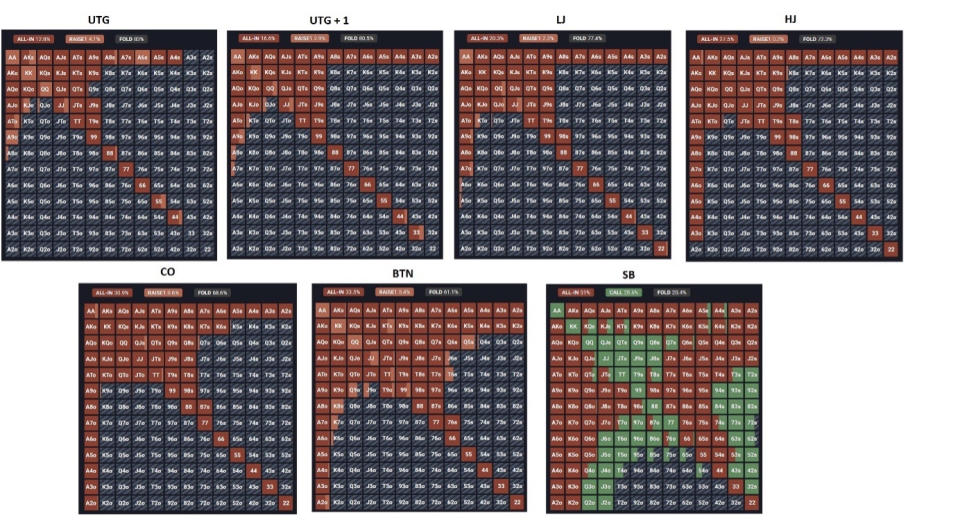
In tournament poker, it is not uncommon to have a stack of 10 or fewer big blinds, leaving you with few options and forcing you to risk your entire stack when you decide to play.
Making optimal decisions with your short stack is very important in tournaments, especially in late games when having a short stack is quite a frequent scenario. Here are the ranges you should be playing with the 10bb stack:
- UTG: Raise or All-In 16.9% - 44+,A4s+,K9s+,QTs+,J9s+,T9s,A9o+,KJo+
- UTG+1: Raise or All-In 19.5% - 33+,A2s+,K9s+,Q9s+,J9s+,T9s,A9o+,KJo+,QJo
- LJ: Raise or All-In 22.6% - 22+,A2s+,K9s+,Q9s+,J9s+,T9s,98s,A7o+,KTo+,QJo
- HJ: All-In 27.7% - 22+,A2s+,K9s+,Q9s+,J9s+,T8s+,98s,A3o+,KTo+,QJo,JTo
- CO: All-In 31.5% - 22+,A2s+,K6s+,Q8s+,J8s+,T8s+,98s,A2o+,KTo+,QTo+,JTo
- BTN: All-In or Raise 38.9% - 22+,A2s+,K2s+,Q5s+,J6s+,T6s+,97s+,87s,A2o+,K7o+,QTo+,JTo
- SB: Call or All-In 77.6% - 22+,A2s+,K2s+,Q2s+,J2s+,T2s+,92s+,82s+,72s+,62s+,52s+,42s+,32s,A2o+,K2o+,Q2o+,J2o+,T4o+,95o+,86o+,75o+,65o
The push fold charts we offer will teach you which hands to push all in with when your stack goes below 15 big blinds.
The charts will also teach you which hands you can still get away with raise/folding or raise/calling, as well as which hands you should fold and which ones you can still limp in the small blind.
Our push-fold tournament charts are based on solver outputs and teach you optimal hand ranges for short-stack tournament scenarios.
Preflop Poker Charts for Cash Games
Cash games can be more complex than tournaments, mostly because the stacks in cash games tend to stay deep throughout the duration of a session.
On the other hand, cash game players don’t have to spend too much time learning how to play poker with a short stack, as such scenarios rarely occur at cash game tables.
Our preflop poker charts for cash games offer optimal solutions for preflop play in 6-Max and Full Ring cash games and simplify the strategy to one that is relatively easy to memorize and implement in actual games.
Poker Preflop Charts for 6-Max
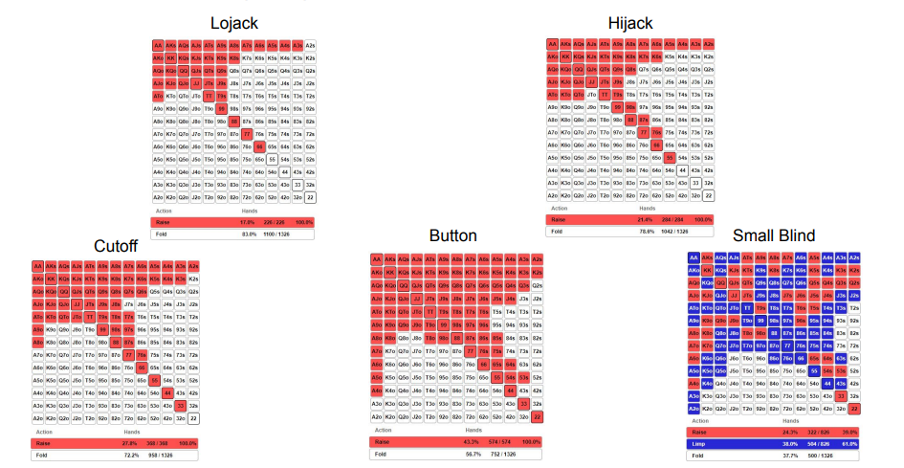
6-Max cash games are extremely popular these days, and our 6-max preflop charts for 6-Max offer a complete game plan for all preflop play in them. Here are the hands you should be opening in a standard 100bb situation:
- LJ: 17.6% - 66+,A3s+,K8s+,Q9s+,J9s+,T9s,ATo+,KJo+,QJo
- HJ: 21.4% - 55+,A2s+,K6s+,Q9s+,J9s+,T9s,98s,87s,76s,ATo+,KTo+,QTo+
- CO: 27.8% - 33+,A2s+,K3s+,Q6s+,J8s+,T7s+,97s+,87s,76s,A8o+,KTo+,QTo+,JTo
- BTN: 43.5% - 33+,A2s+,K2s+,Q3s+,J4s+,T6s+,96s+,85s+,75s+,64s+,53s+,A4o+,K8o+,Q9o+,J9o+,T8o+,98o
- SB: Raise or Call 62.3% - 22+,A2s+,K2s+,Q2s+,J2s+,T3s+,94s+,84s+,74s+,63s+,53s+,43s,A2o+,K4o+,Q5o+,J7o+,T7o+,96o+,86o+,76o
Our charts for 6-Max cash games are dubbed as “implementable” because they do not represent the exact replication of optimal preflop gameplay.
Instead, they give you access to a more simplified strategy that comes as close as possible to actual GTO preflop solutions.
Since solvers often recommend playing the same hand in different ways at certain frequencies, it is nearly impossible to memorize what frequency each hand should be played as a fold, call, or raise.
Our implementable 6-Max charts simplify this strategy to give you one solution for every hand you can get, assuming 100 big blind stacks.
The charts are split into RFI and Facing RFI in position and out of position, as well as Blind vs Blind, offering solutions for all the most frequent situations in 6-Max cash games.
When using the 6-Max preflop charts, remember you should use the following raise sizes:
- Raise to 2.5bb first in
- Raise to 3bb first in from SB
- 3-Bet to 3.5x the raise IP
- 3-Bet to 4x the raise OOP
- Raise to 3.5bb in BB facing SB limp
- 4-bet to 2.5x the 3-bet OOP
- 4-bet to 2.3x the 3-bet IP
Starting Hands for Full-Ring Poker Games (8-max)
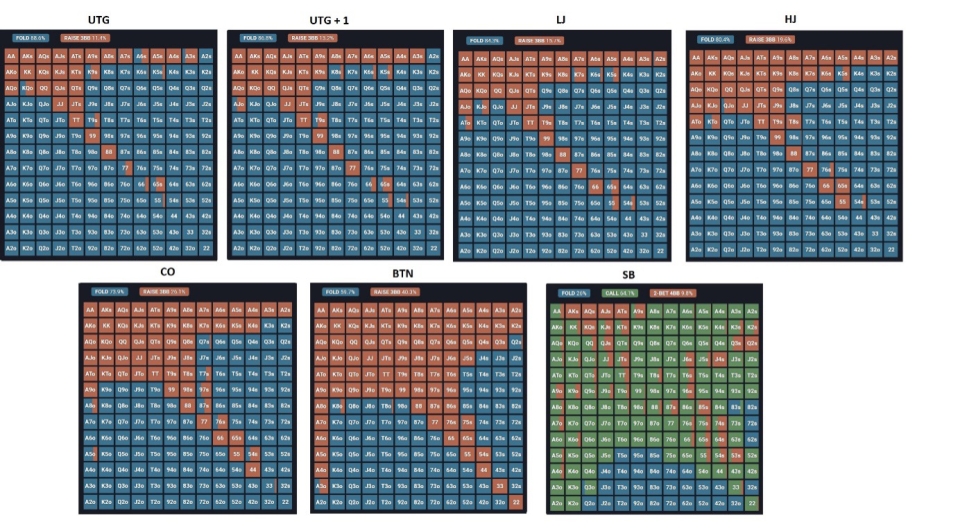
Unlike 6-Max cash games, full-ring cash games are usually played with eight players at a table, which means more hands per orbit and more positions at the table.
Preflop hand ranges for full-ring cash games are similar to those for 6-Max games, except for the two earliest positions, who should play an even tighter range than UTG in 6-Max cash games. Here are the hands:
- UTG: 11.4% - 77+,A3s+,K9s+,QTs+,JTs,T9s,AQo+,KQo
- UTG+1: 13.2% - 77+,A3s+,K8s+,QTs+,JTs,T9s,AJo+,KQo
- LJ: 15.7% - 66+,A2s+,K7s+,QTs+,JTs,T9s,ATo+,KJo+
- HJ: 19.6% - 55+,A2s+,K5s+,Q9s+,J9s+,T9s,ATo+,KTo+,QJo
- CO: 26.1% - 44+,A2s+,K5s+,Q8s+,J8s+,T8s+,97s+,87s,76s,65s,54s,A8o+,KTo+,QTo+,JTo
- BTN: 40.3% - 22+,A2s+,K2s+,Q3s+,J5s+,T6s+,96s+,86s+,76s,65s,54s,A3o+,K8o+,Q9o+,J9o+,T9o
- SB: Call or Raise 73.9% - 22+,A2s+,K2s+,Q2s+,J2s+,T2s+,92s+,84s+,73s+,63s+,52s+,42s+,A2o+,K2o+,Q3o+,J5o+,T6o+,96o+,86o+,75o+,65o,54o
Additionally, if you want to play full-ring cash games, you have to learn how to handle opens from early positions in a full-ring cash game.
You can find all the necessary ranges once you gain access to our full GTO poker ranges calculator, which allows you to generate any range for any position and any stack size you want.
To begin with, learning the downloadable 6-Max cash game preflop charts should be enough, and you should adapt in a full-ring game by playing even tighter from UTG and UTG+1 and also responding to raises from those positions tighter than you would in a 6-Max game.
If you want to take your understanding of full-ring cash games to the next level, get full access to our preflop ranges calculator and find solves for every spot you can come up with at any stack depth and any position you need.
Start out by downloading the appropriate preflop range charts for your game and study the different plays you should make across different stack depths and positions at the poker tables.
What Are Ranges and How Are They Built?
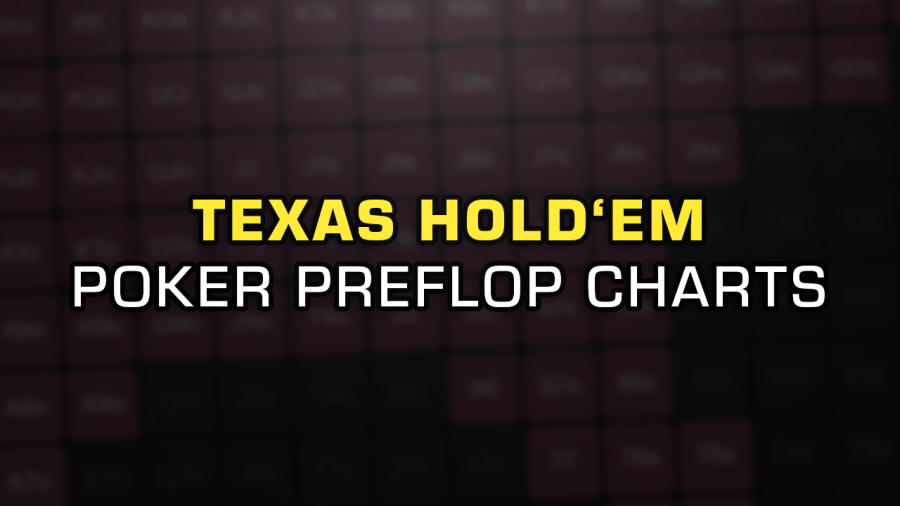
If you are new to poker or have learned poker the old-fashioned way, the idea of poker ranges might be completely new to you. These days, professional poker players discuss the game almost exclusively in terms of hand ranges, and once you fully understand them, so will you.
A poker range is a collection of hands a player can have in a given scenario considering all the actions across different betting street, stack depth, position, and all other relevant factors.
For example, a tight player raising from UTG in a full-ring game might have a range of 8% of all starting hands, which would only entail the best hands in the game.
On the other hand, a splashy player calling from the small blind when everyone folds to them might have as many as 80% of all starting hands.
When playing poker, you should be intelligently constructing your own hand ranges but also thinking about every other player’s potential hand range throughout the hand.
By doing so, you can narrow down the potential hands in your opponents’ ranges and make more informed decisions instead of guessing and saying things like “I put you on AK” when you make a very ambitious river call.
The Most Common Texas Hold’em Ranges
If the idea of poker ranges is new to you, you should start by becoming aware of some common Texas Hold’em hand ranges that players play preflop in different situations.
When learning poker from various coaching materials, you will often see someone refer to a player as having 10%, 15%, or 20% of all hands in a given spot, but you might not understand what that means.
For that purpose, here is a look at some of the most common Texas Hold’em Hand ranges and the hands that those ranges actually consist of:
| Hand Range % | Poker Hands |
|---|---|
| 5% | TT+, AK |
| 10% | 66+, AQ+, A9s+, A5s, KTs+, QTs+, 98s+ |
| 15% | 55+, AJ+, KQ, A2s+, K9s+, Q9s+, J9s+, 76s+ |
| 20% | 22+, AT+, KJ+, QJ, A2s+, K8s+, Q9s+, T8s+, 65s+ |
| 30% | 22+, A9+, All Broadways, A2s+, K7s+, Q7s+, J8s+, 53s+, 43s+ |
| 50% | 22+, A2+, K7+, Q8+, J8+, 98+, 76+, Q2s+, J6s+, T6s+, 96s+, 74s+, 53s+, 32s+ |
If you don’t quite understand how to read the table above, here is a quick explanation of what the different acronyms stand for:
- 22+: Any pocket pair higher than 22
- A7+: Any offsuit A-high hand from AJ to AK
- A2s+: Any suited A-high hand from A2s to AKs
- Suited Broadways: Any suited broadway card combo (A, K, Q, J, T)
- T9+: Any offsuit connectors from T9 to AK
- 43s+: Any suited connectors from 43s to AKs
- 53s+: Any suited one gappers from 53s to AQs
- K9s: Any suited king from K9s to KQs
Keep in mind that all hands from a 20% range are also contained in a 30% range, etc. For this reason, they don't need to be repeated in the table for every range.
Preflop Charts Tips – How to Remember What Hands to Play
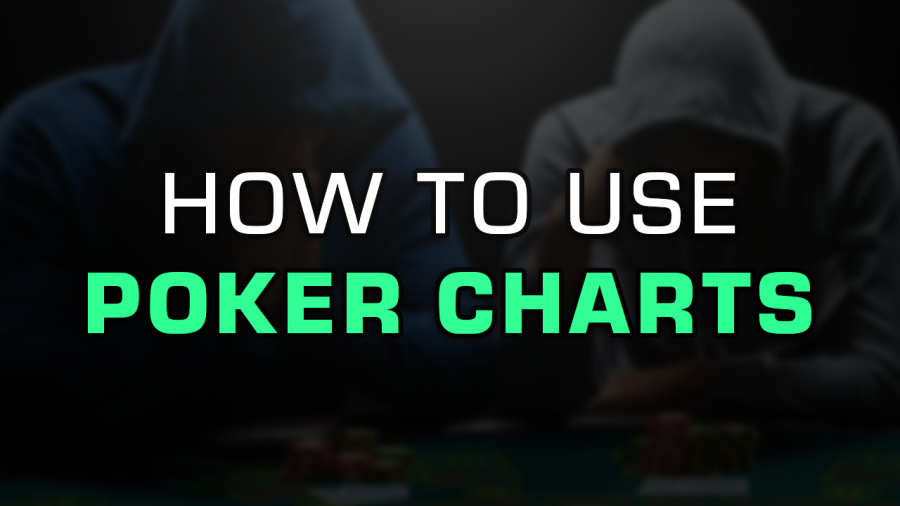
Preflop poker charts offer to make preflop play simpler by always providing you with an optimal solution to all your dilemmas.
However, using poker charts while playing poker is not allowed at all major poker sites, which means you will need to learn your poker strategy beforehand and play without consulting the charts.
Many players struggle to memorize their preflop poker charts perfectly, so we have some tips that will help you memorize the ranges to play in different spots and simplify the process for yourself as much as possible.
Tip #1. How to Use Preflop Charts
The most important thing to remember about preflop poker charts is that they are a learning tool, not a cheating tool.
Using preflop charts to study the game and learn what hands you should play in different scenarios is perfectly acceptable, and all professional poker players study the charts.
However, using preflop charts while playing to help you make decisions is considered cheating, and using charts in this manner is considered unethical.
If you want to make sure that your actions are in full compliance with the rules of the game and the terms and conditions of the online poker operators you are playing with, only use preflop poker charts in between your poker sessions.
You can study poker charts in two ways. One is to try and memorize every last hand on every chart, while the other is to try and memorize the approximate ranges and cutoff hands to make sure you are not straying too far from optimal ranges.
Tip #2. How to Memorize Different Starting Hands
Preflop charts can be very daunting at first, as they contain many different stack sizes, positions, and situations. However, you don’t have to memorize every single hand in every single chart to know what to do when actually playing poker.
Instead, your goal should be to study different charts and try to remember the weakest hands that you would use for certain plays in certain scenarios.
For example, the 100 BB exploitative tournament poker chart shows that you should be opening 27% of hands when folded to you on the cutoff.
Instead of trying to memorize every hand on that chart, you can simply remember that the range includes all pocket pairs, all suited Aces, A8, all Broadways, K7s, Q8s, 64s, and 43s.
These hands all represent the weakest hand in their category. If you are raising A8, you are also raising A9. If you are raising 64s, you are also raising better-suited one-gappers, such as 75s, T8s, etc.
By memorizing the cutoff hands on each preflop chart, you are going to get very close to playing optimally preflop, at least to the extent that preflop charts alone will make possible.
What’s even more, making slight mistakes by raising a hand that’s one pip below the cutoff or folding the cutoff hand will not make a huge difference, as the bottom hands in each range are only slightly profitable plays anyway, and the ones below them are only slightly unprofitable.
Tip #3. How to Adjust Versus Different Opponents
While all preflop poker charts are created using solver solutions and optimal strategies, there is a lot of room in poker to deviate from optimal solutions.
Each poker player plays differently, and many of them deviate quite a bit from the optimal. In fact, most poker players you will encounter in your games won’t play optimally at all. For that reason, there is a lot of room to change up your strategy and exploit your opponents’ tendencies quite a bit.
The real question is how do I deviate from preflop charts in a way that will be profitable against different opponents?
The answer to this question depends heavily on the particular player’s tendencies. If a player is too tight, you can play tighter against them. If they are too loose, you can loosen up as well.
For example, the 6-Max Implementable Preflop Charts suggest that we should 3-Bet ATs in the CO facing a LJ raise. This play is recommended based on optimal frequencies and an opponent that opens an appropriate range of hands.
However, if our opponent in the LJ is extremely tight, a raise with ATs could become significantly less profitable, as their range will not contain enough hands they can fold or hands that we beat.
Instead, some very tight players might only be opening AJ+, and 99+, which means we are completely crushed and should be folding ATs every time.
Of course, to make an extreme adjustment like this, you will need a very strong read on your opponent. Such reads are usually only possible after playing against a player for a long time.
In most other cases, you will only be able to make slight adjustments to your strategy, potentially folding some weaker hands in very wide ranges or adding extra bluffs against opponents who fold too much to 3-bets before the flop.
In either case, remember that preflop charts are always just a recommendation for optimal play and that adjustments to preflop charts can be made based on the reads you may have on your opponents.
Summary – Why You Should Use Preflop Charts
Making the right decisions before the flop sets you up for success on all subsequent streets. Making such decisions without a good plan is hard, and our preflop poker charts offer the best plan you can have.
The charts detail ranges you should be opening, defending, 3-betting, and 4-betting in different poker formats, at different stack sizes, and in different positions.
Learning the preflop poker charts by heart will help make you a complete poker player who knows what the optimal play is in every situation.
However, it is worth keeping in mind that the charts are only a blueprint, which can be altered and deviated from when the need arises.
Start out by studying the charts and remembering the cutoff hands for different situations, and keep on improving by finding spots to deviate from the charts and make even more profitable plays as you move forward.
FAQ
What is a poker range?
A poker range is a collection of poker hands a player can have in a certain scenario. Poker ranges can be expressed in percentages or by outlining the worst hands from each category a range is made up of. Ranges are used to outline a player’s potential holdings without trying to pinpoint the exact hand they are holding.
What are poker preflop charts?
Preflop charts in poker are charts that outline the different poker hands a player should be playing in a given situation. Our preflop charts offer solutions for RFI (raise first in), 3-bet, and 4-bet situations in different positions and at different stack sizes.
How do I memorize poker charts?
It is very difficult to learn all the preflop charts by heart and memorize every hand on them. The best way to go about it is to memorize the worst hand from each category that belongs to a certain chart, also known as the cutoff hands. Once you remember all the cutoff hands, you will easily be able to construct the entire range.
What does RFI stand for?
RFI stands for “raise first in” in poker. RFI preflop charts outline the range of hands you should be raising in a certain position if no player has raised before you and you are the first player making an aggressive action in the hand.
Which poker hand chart is right for me?
We offer many different preflop charts. Our charts are divided into tournament, cash game, and heads-up charts. You should study the charts for the game you play the most and explore the different stack sizes within that game to optimize your results.
